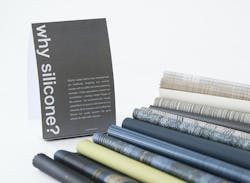Silicone: Five Facts About the High-Performance Material
Although it’s been around for a while, as advancements in technology increase, so do the uses of silicone. But just what is this material, what are its benefits to the user and the world, and how can it be used?
We asked two experts in the field—Ben Wintner, managing principal of Michael Graves Architecture & Design’s product design division, and Hoe Jung, director of Concertex.
Alternatively, Concertex uses silicone to create high-performance textiles, particularly useful in healthcare environments.
Find out more about this material below.
What is silicone made of?
Silicone is a human-made material created by combining the same proportion of elements of different molecular weights, better known as a synthetic polymer. The prefix, Wintner pointed out, comes from the base element of the polymer: sand (silica). Sand is mixed with oxygen, carbon, and hydrogen to create a pliable, rubber-like material which is able to withstand extreme temperatures and heavy use.
What are the advantages of using silicone?
As Jung puts it, “Silicone in itself is a very environmentally- and human-friendly material.”
- It’s pure “green”, meaning it’s made from natural elements
- Unlike polyurethanes, which are sometimes made with oil, silicone does not degrade over time or from hydrolysis (when a compound is broken down via reaction with water into smaller compounds)
- No stains or ink marks can stick to the surface
- Inherently flame retardant
- Does not support microbiological growth
In essence, the key component is that nothing adheres to silicone and no chemicals need to be added to make it a performance fabric.
Wintner added that silicone’s ability to withstand temperatures, including high heat, without breaking down or off-gassing adds to its health benefits. It is also BPA-free (a buzzword for end-users in particular), holds its shape, and is flexible.
According to Jung, the main disadvantages relate to the high price of raw materials and the difficulty in embellishing the material as it doesn’t take prints, nor is it easy to emboss.
Is it sustainable?
The sustainability story of silicone is more involved than understanding how it is disposed of. While silicone is not biodegradable, which is a concern, it can be recycled where facilities exist. It is also made of a natural material—sand—which is abundant, but ultimately a finite resource. (The type of rock that makes up this sand, quartz, is, however, the second most abundant element found in the Earth’s crust.)
Nonetheless, the sustainability aspect of silicone lies in the fact that it can withstand use, making it a simple reusable alternative to single-use products. In fact, in 2012, a study of silicone’s lifestyle found that silicone usage saved an average of nine times the amount of greenhouse gases that are needed to manufacture the material.
Additionally, the use of silicone can greatly increase the productivity and efficiency of products that are used every day.
A wide range of silicone products can be found due to its ability to withstand dramatic differences in temperature, soft touch, ease of production, and durability. In particular, silicone provides advantages for the healthcare sector since it doesn’t need additives to deter microbiological growth, can withstand heavy wear-and-tear, and hold up against cleaning products.
About the Author

Kadie Yale
Former Editor-in-Chief
Kadie Yale holds a BA in Industrial Design from San Francisco State University and a MA in Decorative Art History and Theory from Parsons the New School. In her role as editor-in-chief from 2015-2018, she led the interiors+sources team in creating relevant content that touches on sustainability, universal design, science, and the role of design in society.
